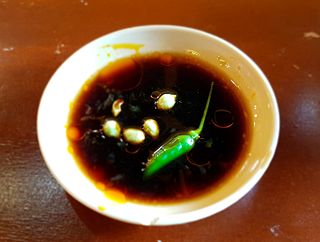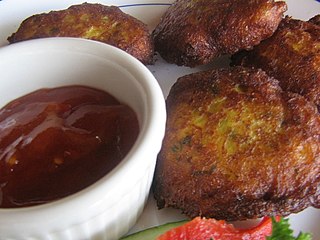Related Research Articles

Curry is a dish with a sauce or gravy seasoned with spices, mainly derived from the interchange of Indian cuisine with European taste in food, starting with the Portuguese, followed by the Dutch and British, and then thoroughly internationalised. Many dishes that would be described as curries in English are found in the native cuisines of countries in Southeast Asia and East Asia.

Apple sauce is a purée made of apples. It can be made with peeled or unpeeled apples and can be spiced or sweetened. Apple sauce is inexpensive and is widely consumed in North America and some parts of Europe.

Ketchup or catsup is a table condiment with a sweet and sour flavor. "Ketchup" now typically refers to tomato ketchup, although early recipes for various different varieties of ketchup contained mushrooms, oysters, mussels, egg whites, grapes, or walnuts, among other ingredients.

A chutney is a spread typically associated with cuisines of the Indian subcontinent. Chutneys are made in a wide variety of forms, such as a tomato relish, a ground peanut garnish, yogurt, or curd, cucumber, spicy coconut, spicy onion, or mint dipping sauce.

Rémoulade is a cold sauce. Although similar to tartar sauce, it is often more yellowish, sometimes flavored with curry, and often contains chopped pickles or piccalilli. It can also contain horseradish, paprika, anchovies, capers and a host of other items.

Hot sauce is a type of condiment, seasoning, or salsa made from chili peppers and other ingredients. Many commercial varieties of mass-produced hot sauce exist.

Momos are a type of steamed filled dumpling in Tibetan and Nepali cuisine that is also popular in neighbouring Bhutan, Bangladesh, and India. The majority of Tibetan momos are half-moon in shape like jiaozi, while Nepali momos are normally round like baozi. Momos are usually served with a sauce known as achar influenced by the spices and herbs used within many South Asian cuisines. It can also be used in soup, as in jhol momo and mokthuk.

Manti is a type of dumpling mainly found in Turkish cuisine, Armenian cuisine and Central Asian cuisine but also in West Asia, South Caucasus, and the Balkans. Manti is also popular among Chinese Muslims, and it is consumed throughout post-Soviet countries, where the dish spread from the Central Asian republics. The dumplings typically consist of a spiced meat mixture, usually lamb or ground beef, wrapped in a thin dough sheet which is then boiled or steamed. The size and shape of manti vary significantly depending on geographic location.

The generic term for condiments in the Filipino cuisine is sawsawan. Unlike sauces in other Southeast Asian regions, most sawsawan are not prepared beforehand, but are assembled on the table according to the preferences of the diner.

Ají is a spicy sauce that contains ají peppers, oil, tomatoes, cilantro (coriander), garlic, onions, and water. It is served as a condiment to complement main dishes, most oftentimes in Latin American cuisines, and prepared by blending its ingredients using a food processor or blender. Although ají sauce recipes can vary from person to person, there are generally country-specific and region-specific varieties.

Chili sauce and chili paste are condiments prepared with chili peppers.

Hot chicken is a type of fried chicken that is a local specialty of Nashville, Tennessee, in the United States. In its typical preparation, it is a portion of breast, thigh or wing that has been marinated in a water-based blend of seasoning, floured, fried and finally covered in a paste or sauce that has been spiced with cayenne pepper. This method of preparation originates within African American communities in the Southern United States. A richly pigmented seasoning paste gives the fried chicken its reddish hue. Spice blends, preparation methods and heat intensity vary from recipe to recipe or depending on the chef.
Frank's RedHot is a hot sauce made from a variety of cayenne peppers, produced by McCormick & Company. The Original blend ranks low on the Scoville scale, with 450 SHUs, but the XTRA Hot variety measures 2,000 SHUs.
Sepen may refer to:

Crab in Padang sauce or Padang crab is an Indonesian seafood dish of crab served in hot and spicy Padang sauce. It is one of the two most popular ways that crab is served in Indonesia, commonly found in coastal cities with abundant seafood, such as Padang, Jakarta, Medan, Surabaya, Makassar and Cirebon. Its closest analogue probably is chili crab; however, Padang crab uses richer spices.

Sichuan pepper (Chinese: 花椒; pinyin: huājiāo, also known as Sichuanese pepper, Szechuan pepper, Chinese prickly ash, Chinese pepper, Mountain pepper, and mala pepper, is a spice commonly used in Sichuan cuisine in China, and in northeast India. It is called mejenga in Assam, India. In Nepal, Timur or Timut pepper is a commonly used spice and is often confused with Sichuan pepper because they look similar and both share some characteristics. Despite its name, Sichuan pepper is not closely related to black pepper or chili peppers. It is made from plants of the genus Zanthoxylum in the family Rutaceae, which includes citrus and rue.

Ikan goreng is a hot dish consisting of deep fried fish or other forms of seafood. Ikan goreng literally means "fried fish" in Indonesian and Malay languages.

Sambal is an Indonesian chili sauce or paste, typically made from a mixture of a variety of chilli peppers with secondary ingredients such as shrimp paste, garlic, ginger, shallot, scallion, palm sugar, and lime juice. Sambal is an Indonesian loanword of Javanese origin. It originated from the culinary traditions of Indonesia and is also an integral part of the cuisines of Singapore, Malaysia, Brunei, and Sri Lanka. It has also spread through overseas Indonesian populations to the Netherlands and Suriname.

Babi kecap is an Indonesian braised pork with sweet soy sauce. It is a Chinese Indonesian classic, due to its simplicity and popularity among Chinese Indonesian households. It is also popular among non-Muslim Indonesians, such as the Balinese, Ambonese, Bataks, Minahasans, and Dayaks, and in the Netherlands among the Indo-Dutch, where it is known as babi ketjap, owing to colonial ties with Indonesia. In the Netherlands, the dish might also be served within an opulent rijsttafel banquet.
References
- ↑ "Sepen, or Tibetan Hot Sauce – Recipe". The New York Times . Retrieved 23 January 2014.
- ↑ "Sepen: Tibetan Hot Sauce". Yowangdu. Retrieved 25 October 2014.
- ↑ "Tsering's Tibetan Hot Sauce (Sepen) Recipe". Yowangdu. Archived from the original on 21 September 2018. Retrieved 25 October 2014.